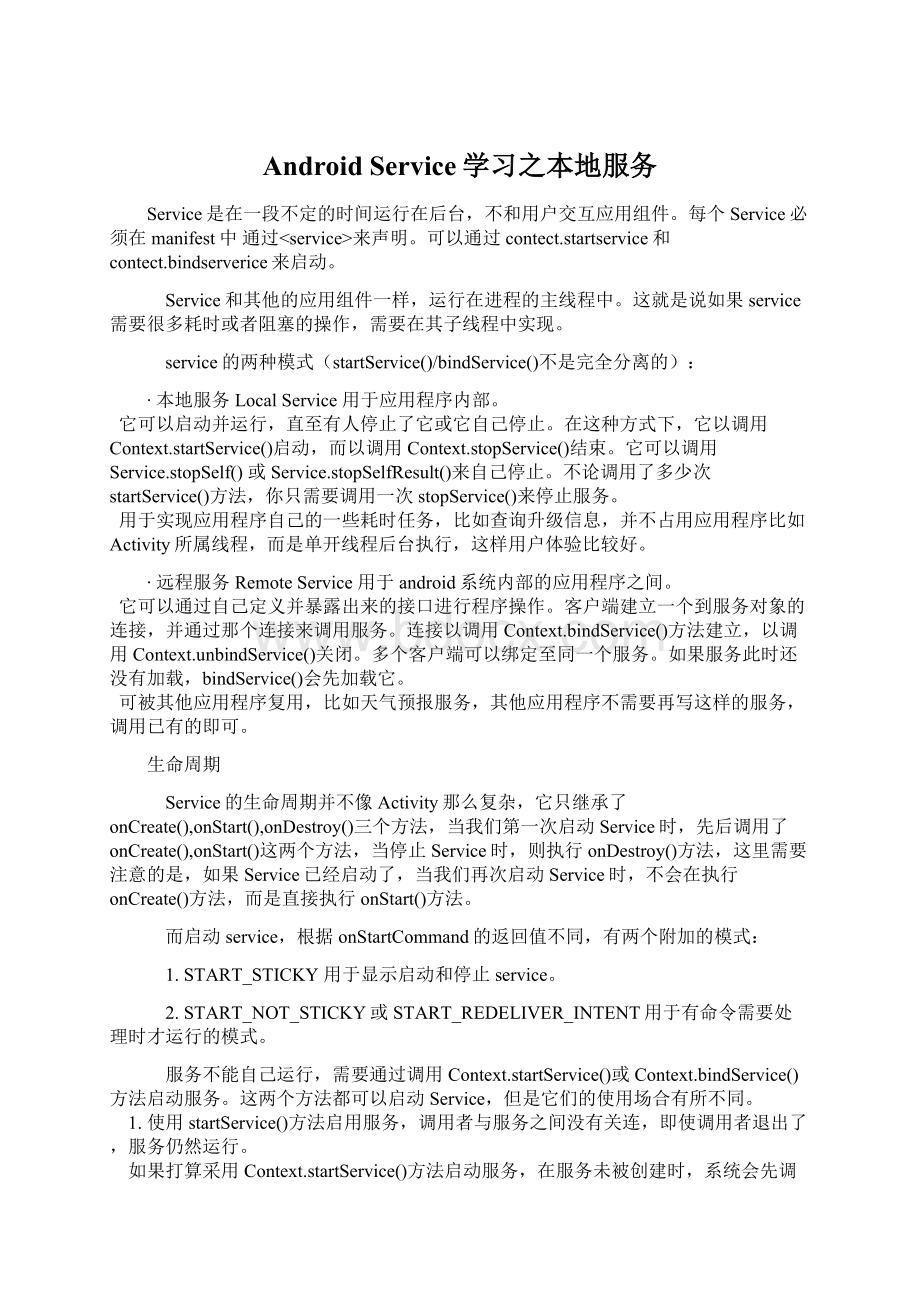Android Service学习之本地服务.docx
《Android Service学习之本地服务.docx》由会员分享,可在线阅读,更多相关《Android Service学习之本地服务.docx(9页珍藏版)》请在冰豆网上搜索。

AndroidService学习之本地服务
Service是在一段不定的时间运行在后台,不和用户交互应用组件。
每个Service必须在manifest中通过来声明。
可以通过contect.startservice和contect.bindserverice来启动。
Service和其他的应用组件一样,运行在进程的主线程中。
这就是说如果service需要很多耗时或者阻塞的操作,需要在其子线程中实现。
service的两种模式(startService()/bindService()不是完全分离的):
∙本地服务 LocalService用于应用程序内部。
它可以启动并运行,直至有人停止了它或它自己停止。
在这种方式下,它以调用Context.startService()启动,而以调用Context.stopService()结束。
它可以调用Service.stopSelf()或Service.stopSelfResult()来自己停止。
不论调用了多少次startService()方法,你只需要调用一次stopService()来停止服务。
用于实现应用程序自己的一些耗时任务,比如查询升级信息,并不占用应用程序比如Activity所属线程,而是单开线程后台执行,这样用户体验比较好。
∙远程服务 RemoteService用于android系统内部的应用程序之间。
它可以通过自己定义并暴露出来的接口进行程序操作。
客户端建立一个到服务对象的连接,并通过那个连接来调用服务。
连接以调用Context.bindService()方法建立,以调用Context.unbindService()关闭。
多个客户端可以绑定至同一个服务。
如果服务此时还没有加载,bindService()会先加载它。
可被其他应用程序复用,比如天气预报服务,其他应用程序不需要再写这样的服务,调用已有的即可。
生命周期
Service的生命周期并不像Activity那么复杂,它只继承了onCreate(),onStart(),onDestroy()三个方法,当我们第一次启动Service时,先后调用了onCreate(),onStart()这两个方法,当停止Service时,则执行onDestroy()方法,这里需要注意的是,如果Service已经启动了,当我们再次启动Service时,不会在执行onCreate()方法,而是直接执行onStart()方法。
而启动service,根据onStartCommand的返回值不同,有两个附加的模式:
1.START_STICKY用于显示启动和停止service。
2.START_NOT_STICKY或START_REDELIVER_INTENT用于有命令需要处理时才运行的模式。
服务不能自己运行,需要通过调用Context.startService()或Context.bindService()方法启动服务。
这两个方法都可以启动Service,但是它们的使用场合有所不同。
1.使用startService()方法启用服务,调用者与服务之间没有关连,即使调用者退出了,服务仍然运行。
如果打算采用Context.startService()方法启动服务,在服务未被创建时,系统会先调用服务的onCreate()方法,接着调用onStart()方法。
如果调用startService()方法前服务已经被创建,多次调用startService()方法并不会导致多次创建服务,但会导致多次调用onStart()方法。
采用startService()方法启动的服务,只能调用Context.stopService()方法结束服务,服务结束时会调用onDestroy()方法。
2.使用bindService()方法启用服务,调用者与服务绑定在了一起,调用者一旦退出,服务也就终止,大有“不求同时生,必须同时死”的特点。
onBind()只有采用Context.bindService()方法启动服务时才会回调该方法。
该方法在调用者与服务绑定时被调用,当调用者与服务已经绑定,多次调用Context.bindService()方法并不会导致该方法被多次调用。
采用Context.bindService()方法启动服务时只能调用onUnbind()方法解除调用者与服务解除,服务结束时会调用onDestroy()方法。
看看官方给出的比较流程示意图:
官方文档告诉我们,一个service可以同时start并且bind,在这样的情况,系统会一直保持service的运行状态如果service已经start了或者BIND_AUTO_CREATE标志被设置。
如果没有一个条件满足,那么系统将会调用onDestory方法来终止service.所有的清理工作(终止线程,反注册接收器)都在onDestory中完成。
拥有service的进程具有较高的优先级
官方文档告诉我们,Android系统会尽量保持拥有service的进程运行,只要在该service已经被启动(start)或者客户端连接(bindService)到它。
当内存不足时,需要保持,拥有service的进程具有较高的优先级。
1.如果service正在调用onCreate,onStartCommand或者onDestory方法,那么用于当前service的进程则变为前台进程以避免被killed。
2.如果当前service已经被启动(start),拥有它的进程则比那些用户可见的进程优先级低一些,但是比那些不可见的进程更重要,这就意味着service一般不会被killed.
3.如果客户端已经连接到service(bindService),那么拥有Service的进程则拥有最高的优先级,可以认为service是可见的。
4.如果service可以使用startForeground(int,Notification)方法来将service设置为前台状态,那么系统就认为是对用户可见的,并不会在内存不足时killed。
如果有其他的应用组件作为Service,Activity等运行在相同的进程中,那么将会增加该进程的重要性。
本地service
1.不需和Activity交互的本地服务
public class LocalService extends Service {
private static final StringTAG= "LocalService";
@Override
public IBinderonBind(Intentintent){
Log.i(TAG, "onBind");
return null;
}
@Override
public void onCreate(){
Log.i(TAG, "onCreate");
super.onCreate();
}
@Override
public void onDestroy(){
Log.i(TAG, "onDestroy");
super.onDestroy();
}
@Override
public void onStart(Intentintent, int startId){
Log.i(TAG, "onStart");
super.onStart(intent,startId);
}
}
Activity:
public class ServiceActivity extends Activity{
@Override
protected void onCreate(BundlesavedInstanceState){
super.onCreate(savedInstanceState);
setContentView(R.layout.servicedemo);
((Button)findViewById(R.id.startLocalService)).setOnClickListener(
new View.OnClickListener(){
@Override
public void onClick(Viewview){
//TODOAuto-generatedmethodstub
startService(new Intent("com.demo.SERVICE_DEMO"));
}
});
((Button)findViewById(R.id.stopLocalService)).setOnClickListener(
new View.OnClickListener(){
@Override
public void onClick(Viewview){
//TODOAuto-generatedmethodstub
stopService(new Intent("com.demo.SERVICE_DEMO"));
}
});
}
}
在AndroidManifest.xml添加:
name=".LocalService">
name="com.demo.SERVICE_DEMO" />
name="android.intent.category.default" />
否则启动服务时会提示newIntent找不到"com.demo.SERVICE_DEMO"。
对于这类不需和Activity交互的本地服务,是使用startService/stopService的最好例子。
运行时可以发现第一次startService时,会调用onCreate和onStart,在没有stopService前,无论点击多少次startService,都只会调用onStart。
而stopService时调用onDestroy。
再次点击stopService,会发现不会进入service的生命周期的,即不会再调用onCreate,onStart和onDestroy。
而onBind在startService/stopService中没有调用。
2.本地服务和Activity交互
对于这种case,官方的sample(APIDemo\app.LocalService)是最好的例子:
/**
*Thisisanexampleofimplementinganapplicationservicethatrunslocally
*inthesameprocessastheapplication. The{@linkLocalServiceController}
*and{@linkLocalServiceBinding}classesshowhowtointeractwiththe
*service.
*
*
Noticetheuseofthe{@linkNotificationManager}wheninterestingthings
*happenintheservice. Thisisgenerallyhowbackgroundservicesshould
*interactwiththeuser,ratherthandoingsomethingmoredisruptivesuchas
*callingstartActivity().
*/
public class LocalService extends Service{
private NotificationManagermNM;
/**
*Classforclientstoaccess. Becauseweknowthisservicealways
*runsinthesameprocessasitsclients,wedon'tneedtodealwith
*IPC.
*/
public class LocalBinder extends Binder{
LocalServicegetService(){
return LocalService.this;
}
}
@Override
public void onCreate(){
mNM=(NotificationManager)getSystemService(NOTIFICATION_SERVICE);
//Displayanotificationaboutusstarting. Weputaniconinthestatusbar.
showNotification();
}
@Override
public int onStartCommand(Intentintent, int flags, int startId){
Log.i("LocalService", "Receivedstartid" +startId+ ":
" +intent);
//Wewantthisservicetocontinuerunninguntilitisexplicitly
//stopped,soreturnsticky.
return START_STICKY;
}
@Override
public void onDestroy(){
//Cancelthepersistentnotification.
mNM.cancel(R.string.local_service_started);
//Telltheuserwestopped.
Toast.makeText(this,R.string.local_service_stopped,Toast.LENGTH_SHORT).show();
}
@Override
publicIBinderonBind(Intentintent){
returnmBinder;
}
//Thisistheobjectthatreceivesinteractionsfromclients. See
//RemoteServiceforamorecompleteexample.
private final IBindermBinder= new LocalBinder();
/**
*Showanotificationwhilethisserviceisrunning.
*/
private void showNotification(){
//Inthissample,we'llusethesametextforthetickerandtheexpandednotification
CharSequencetext=getText(R.string.local_service_started);
//Settheicon,scrollingtextandtimestamp
Notificationnotification= new Notification(R.drawable.stat_sample,text,
System.currentTimeMillis());
//ThePendingIntenttolaunchouractivityiftheuserselectsthisnotification
PendingIntentcontentIntent=PendingIntent.getActivity(this,0,
new Intent(this,LocalServiceController.class),0);
//Settheinfofortheviewsthatshowinthenotificationpanel.
notification.setLatestEventInfo(this,getText(R.string.local_service_label),
text,contentIntent);
//Sendthenotification.
//Weusealayoutidbecauseitisauniquenumber. Weuseitlatertocancel.
mNM.notify(R.string.local_service_started,notification);
}
}
这里可以发现onBind需要返回一个IBinder对象。
也就是说和上一例子LocalService不同的是,
1.添加了一个public内部类继承Binder,并添加getService方法来返回当前的Service对象;
2.新建一个IBinder对象——new那个Binder内部类;
3.onBind方法返还那个IBinder对象。
Activity:
/**
*
Exampleofbindingandunbindingtothe{@linkLocalService}.
*Thisdemonstratestheimplementationofaservicewhichtheclientwill
*bindto,receivinganobjectthroughwhichitcancommunicatewiththeservice.
*/
public class LocalServiceBinding extends Activity{
private boolean mIsBound;
private LocalServicemBoundService;
@Override
protected void onCreate(BundlesavedInstanceState){
super.onCreate(savedInstanceState);
setContentView(R.layout.local_service_binding);
//Wat